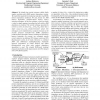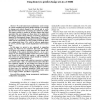741 search results - page 3 / 149 » Memory Dependence Prediction Using Store Sets |
ISCA
1995
IEEE
13 years 9 months ago
1995
IEEE
Accurate instruction fetch and branch prediction is increasingly important on today’s wide-issue architectures. Fetch prediction is the process of determining the next instructi...
MICRO
1999
IEEE
13 years 10 months ago
1999
IEEE
: We identify that typical programs exhibit highly regular read-after-read (RAR) memory dependence streams. We exploit this regularity by introducing read-after-read (RAR) memory d...
MICRO
1998
IEEE
13 years 10 months ago
1998
IEEE
Load latency remains a significant bottleneck in dynamically scheduled pipelined processors. Load speculation techniques have been proposed to reduce this latency. Dependence Pred...
ICS
2005
Tsinghua U.
13 years 11 months ago
2005
Tsinghua U.
With the increasing performance gap between the processor and the memory, the importance of caches is increasing for high performance processors. However, with reducing feature si...
CSMR
2010
IEEE
13 years 22 days ago
2010
IEEE
To avoid unnecessary maintenance costs in large IT systems resulting from poorly planned changes, it is essential to manage and control changes to the system and to verify that all...


